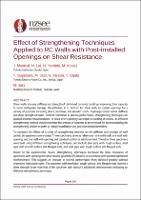| dc.description.abstract | Shear walls increase stiffness and strength of reinforced concrete frame buildings improving their capacity to resist earthquake damage. Nevertheless, it is common for shear walls to contain openings for a variety of purposes including doors, windows, and elevator shafts. Openings reduce initial stiffness and shear strength of walls. To limit reductions in seismic performance, strengthening techniques are applied around critical locations. In cases where openings are made in existing structures, an efficient strengthening method should minimize the amount of concrete to be removed for accommodating the strengthening device in order to reduce installation cost and operational downtime.
To compare the effects of a range of strengthening methods on the stiffness and strength of wall panels, six specimens were tested. Three specimens serve as references - one solid wall, one wall with opening, and one wall with opening and standard additional reinforcement. The other three specimens were built using different strengthening techniques, and include steel pipe with rough surface, steel pipe with smooth surface and flanged ends, and steel pipe with rough surface and flanged ends.
Based on the experimental results, strengthening techniques increased the shear resistance of specimens with openings for shear strains up until 0.2% relative to specimens with standard additional reinforcement. This suggests an increase in seismic performance from standard practice without expensive fabrication costs. The specimen with steel pipe, rough surface, and flanged ends reached a shear strength larger than that of the specimen with standard additional reinforcement indicating an effective strengthening technique. | |

